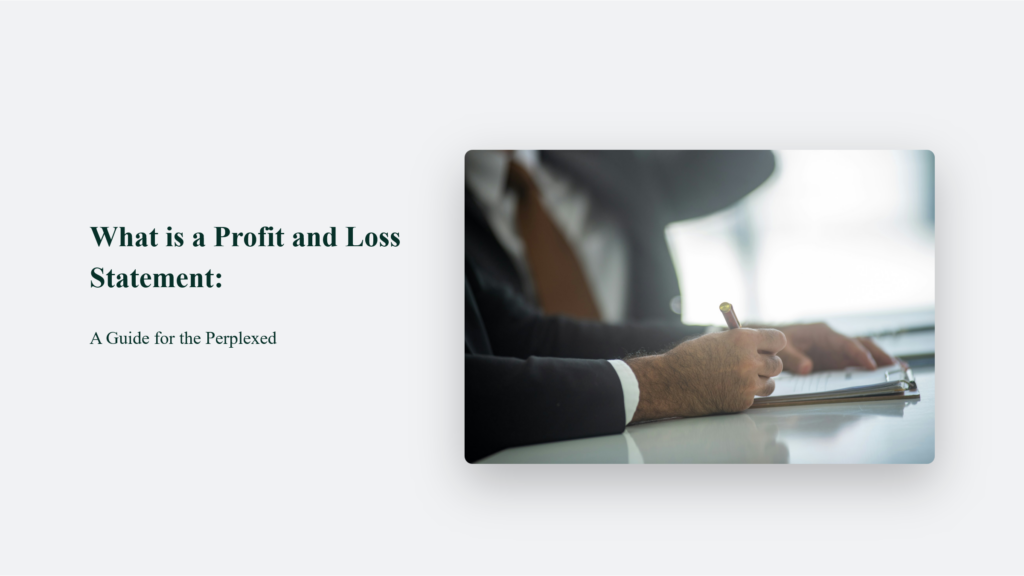

What is a Profit and Loss Statement: A Guide for the Perplexed

As Seen On
“Ah, the Profit and Loss Statement – the beacon in the foggy world of business finance!” If you’re entering the business world, whether as a fresh entrepreneur or a seasoned mogul, understanding a profit and loss (P&L) statement is crucial. But what is a profit and loss statement, and why does it hold such sway in the corridors of commerce?

What is a Profit and Loss Statement?
A profit and loss statement, also known as an income statement or statement of operations, is essentially the financial scorecard of a business. Consider it a summary of a company’s financial performance over a specific period, like a fiscal quarter or a year. It’s a tale of what the business earned (revenues), what it spent (expenses), and the resulting tale of profit or loss. This document is crucial for assessing a business’s financial health and making informed decisions.
The Anatomy of a P&L Statement
The Profit and Loss (P&L) Statement, often called the income statement, is a critical financial document for any business. It provides a snapshot of the company’s financial performance over a specific period, usually a quarter or a year. This statement is essential for understanding how a company earns revenue and incurs expenses. Let’s delve into the anatomy of a P&L statement to understand it better:
Revenue (Sales):
It is the starting line of the P&L statement and represents the total income generated from selling goods or services. Revenue is the lifeline of any business and the primary income source. The way revenue is recognized can depend on the accounting principles adopted by the company, like accrual or cash accounting.
Cost of Goods Sold (COGS):
Directly following the revenue is the Cost of Goods Sold (COGS). COGS represents the direct costs attributable to the production of a company’s goods, including raw materials and labour costs. It’s important to note that COGS does not include indirect expenses such as marketing or administrative costs.
Gross Profit:
Calculated as Revenue minus COGS, gross profit reflects a company’s production and sale efficiency. It is an indicator of a business’s core profitability before accounting for other operating expenses.
Expenses:
Expenses on a P&L statement are categorized into operating and non-operating expenses. Operating expenses include items like salaries, rent, utilities, and marketing—expenses necessary for the day-to-day running of the business. Non-operating expenses, on the other hand, might include interest payments on loans and taxes.
Net Profit or Loss:
It is often referred to as the “bottom line.” It is the amount of money left after all the revenues have been collected and all the expenses have been paid. This figure tells us whether the company has made a profit or incurred a loss during the reporting period.
Understanding the P&L statement is vital for stakeholders, including investors, managers, and creditors, as it provides insight into the company’s operational efficiency, cost structure, and profitability. The P&L statement also aids in making informed business decisions and strategic planning.
The Magic of Deciphering a P&L Statement:
Here’s a guide to help you decode this financial document:
Starting at the Top: Revenue
The top of the P&L statement is where the journey begins. It showcases the total revenue or sales made by the business during a specific period. This figure is critical as it sets the stage for the rest of the statement and represents the income generated from the core business activities.
The Cost of Doing Business: COGS and Gross Profit
Next comes the Cost of Goods Sold (COGS). This includes the direct costs associated with producing the goods or services the business sells. Subtracting COGS from Revenue gives us Gross Profit, an indicator of how efficiently a business produces and sells its products.
Operational Insight: Operating Expenses
Following Gross Profit, the P&L statement lists Operating Expenses. These are the costs involved in running the business that aren’t directly tied to production, like rent, utilities, salaries, and marketing expenses. This section offers insight into how well the business manages its operational costs.
Net Profit or Loss:
Finally, we arrive at the Net Profit or Loss, commonly known as the bottom line. It’s calculated by subtracting total expenses (including COGS and Operating Expenses) from total revenue. This figure is the ultimate indicator of a business’s financial health over the reporting period.
The Role of a P&L Statement in Business Forecasting
Financial Health Indicator:
The P&L statement is like a business report card, revealing its financial health. It shows whether a business is profitable or operating at a loss by outlining the revenue it generates and the costs it incurs.
Trend Analysis:
By comparing P&L statements over different periods, businesses can identify trends in income and expenditure. For example, an increasing trend in expenses without a proportional increase in revenue might indicate inefficiencies that need to be addressed.
Decision-Making and Strategy Formulation:
The insights from a P&L statement guide business owners and managers in making informed decisions. For instance, identifying areas with high costs can lead to strategizing on cost reduction or reallocating resources for better profitability.
Performance Measurement:
It measures the effectiveness of business strategies and decisions implemented in a given period. For instance, a marketing campaign’s success can be evaluated based on the increase in sales revenue.
Red Flags Identification:
A continuous decline in net profit, as revealed by successive P&L statements, could be a red flag, indicating underlying problems in the business model, market competition, or operational inefficiencies.
Investor and Stakeholder Communication:
A well-maintained P&L statement is crucial for businesses seeking investment as it provides investors with a clear picture of the company’s financial standing and potential for future growth.
Regulatory Compliance:
For public companies and in certain regulatory environments, regular preparation of P&L statements is a legal requirement, ensuring transparency in financial reporting.
In Summary:
Understanding a profit and loss statement is like learning a new language, the language of business finance. It’s not just about numbers on a page; it’s a narrative of your business’s financial journey. By mastering this, you’re not just keeping score but unlocking the potential to write your business success story.
Frequently Asked Questions:
Is a profit and loss statement the same as an income statement?
Yes, they are essentially the same. The term “profit and loss statement” is more commonly used internally within a company, while “income statement” is used in a more formal, external context.
How often should a business prepare a P&L statement?
Preparing a P&L statement monthly, quarterly, or annually is common practice. Monthly statements align well with bank cycles and provide a more frequent financial health overview.
Can small businesses create their own P&L statements?
Absolutely! Small businesses can start with basic templates available online and evolve them as the business grows. It’s essential to understand the distinction between direct costs (COGS) and indirect expenses (operating expenses) for accurate P&L statements.
Konger
Up until working with Casey, we had only had poor to mediocre experiences outsourcing work to agencies. Casey & the team at CJ&CO are the exception to the rule.
Communication was beyond great, his understanding of our vision was phenomenal, and instead of needing babysitting like the other agencies we worked with, he was not only completely dependable but also gave us sound suggestions on how to get better results, at the risk of us not needing him for the initial job we requested (absolute gem).
This has truly been the first time we worked with someone outside of our business that quickly grasped our vision, and that I could completely forget about and would still deliver above expectations.
I honestly can't wait to work in many more projects together!
Disclaimer
*The information this blog provides is for general informational purposes only and is not intended as financial or professional advice. The information may not reflect current developments and may be changed or updated without notice. Any opinions expressed on this blog are the author’s own and do not necessarily reflect the views of the author’s employer or any other organization. You should not act or rely on any information contained in this blog without first seeking the advice of a professional. No representation or warranty, express or implied, is made as to the accuracy or completeness of the information contained in this blog. The author and affiliated parties assume no liability for any errors or omissions.

